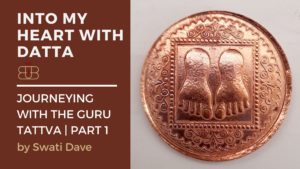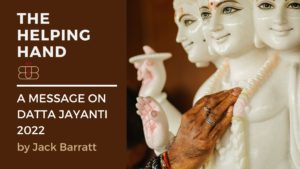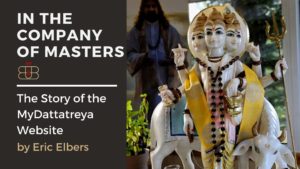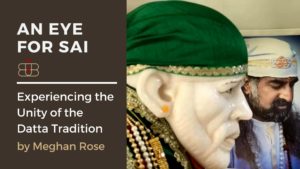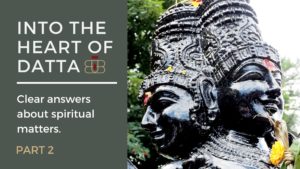Sri Datta Swami
Overview and Significance
Shri Datta Swami is a complete incarnation of the Lord (Pari Purna Avatara). He has come to this world to preach Divine Knowledge to humanity. In the past embodiments of the Lord, this wonderful Divine Knowledge was not revealed to its fullest extent. Today, more than ever, there is a real need for this beautiful Divine Knowledge. The situation is rather peculiar. People are not ignorant about true knowledge. They are very knowledgeable. The advancement in science and technology has sharpened their minds. They know the truth but do not like it. They want to reach the true goal by the false and convenient path. For this purpose, they have twisted the meaning of the scriptures. Humanity stands divided by many religions and religious sects. Therefore, there is an immediate need at present for Lord Datta Himself to come down and reveal the true knowledge. He has come in the form of His Holiness Shri Datta Swami to give Divine and special knowledge to us.
The same single God revealed Himself in different forms, in different places, in different times, to different people. He granted the same enlightenment to all in different religions. The correlation between the religions will bring unity and world peace, which is the main aim of universal religion. Spreading this wonderful spiritual knowledge is counted as a real service to God.
― Shri Datta Swami
Life History
Swami’s Ancestors. In recent times in the village of Nagulwaram, lived a devout Brahmin (priest) called Sri Koteswara Sastry. He belonged to the lineage (gotra) of Sage Kashyapa. He spent his entire life repeating the name of the Lord (Rama Nama Japam). Even when he passed away, the name of the Lord alone was on his lips, and his fingers were counting the rosary. His son, Sri Veerabhadra Shastry is a poet in Sanskrit and Telugu and has written more than a hundred books. He is also a great astrologer. His wife is called Hanumayamma.
Two distant cousins of Sri Veerabhadra Shastry were evil sorcerers. They were skilled in black magic and had terrorised the whole village. They had the power to kill people with a mere look or the utterance of certain words or mantras. They used to worship ghosts, evil forces, and demons. Cemeteries and cremation grounds used to be their haunts. According to some people’s estimate, they had killed hundreds of people, including over three hundred children, using their evil powers. They were sworn enemies of Sri Veerabhadra Shastry and had cast an evil spell on Sri Veerabhadra Shastry’s family that his lineage may come to an end. As a result of the spell, seven children in the joint family, which included Sri Veerabhadra Shastry and his two brothers, had died.
The eighth child. When Hanumayamma was pregnant with the eighth child in the extended family of Sri Veerabhadra Shastry, there was a lot of anxiety for the infant’s survival. On Sunday, phalguna shukla vidiya, in the early hours of the 4th part of uttarabhadra, makara lagna, vyaya year, (February 24th, 1947), the child of Veerabhadra Shastry and Hanumayamma was born. The child was a boy. As soon as he was born, the two evil sorcerers, who had tried to destroy the family of Sri Veerabhadra Shastry, died all of a sudden. The two sorcerers were paternal uncles of the newborn child. With their death, the evil influence on the family and the entire village ended.
The name-giving ceremony (namakarana) was postponed until age seven. The family was still afraid that he might not survive, since the earlier seven children had died only after their ceremony. Little did the family know that this boy was none other than the Lord Himself and that he would be known as Swami (master, Lord) or Datta Swami in the future. There are several parallels between the life of Lord Krishna and Swami. Lord Krishna was the eighth child of his parents. Swami was the eighth child in his family. Lord Krishna’s maternal uncle was a very cruel king and had killed the elder siblings of Lord Krishna along with innumerable innocent people. In Swami’s case, his two paternal uncles were cruel and had killed Swami’s elder siblings and cousins apart from hundreds of other villagers. Owing to the similarities between Lord Krishna and Swami, his paternal aunt, named him ‘Venugopala Krishna Murthy.’
Early Life
Swami the prankster. As Swami grew up to be a young boy, he brought life and enthusiasm to his family and the whole village. His enchanting pranks at once entertained and exasperated his parents. His mischief was very similar to that of Lord Krishna. Like Lord Krishna, Swami was well fond of butter and curd. He too, would collect a band of village kids and sneak into neighbor’s homes to steal butter and curd. His whole day would be spent playing with his band of friends, teasing villagers, and breaking their earthen pots. His friends adored him and considered him as their leader. Despite his constant mischief, he was the heart-throb of the entire village. Occasionally, some villagers would complain to Swami’s parents about his being a perfect menace. But on the whole, they tolerated and even enjoyed his pranks.
Swami’s upanayanam. When Swami turned seven, just a few days after his christening ceremony (namakarana), his father decided that it was about time that his son got a little serious. To reduce the mischief of Swami and instill some discipline in him, his father performed the upanayanam ceremony for Swami. The upanayanam is the initiation of a child into the traditional study of the scriptures. A large ceremony was performed, and food was distributed to the entire village. After the upanayanam, Swami’s father started teaching Sanskrit to Swami. He began by teaching eight verses from the epic, Raghuvamsha of Kalidasa. But from the ninth verse onwards, Swami began to reveal the meanings of Sanskrit verses without any further teaching. This happened when Swami was seven years of age. The father was taken aback by the extraordinary talent of his seven-year-old son. However, he was worried and thought that Swami might be possessed by a ‘Brahma Rakshasa’, the ghost of a scholarly demon. As a result, Swami could suddenly expound the Sanskrit epic without any prior study. His father performed several rituals and the chanting of mantras (sacred hymns) so that Swami may get rid of the ‘Brahma Rakshasa.’ He had no idea of the divinity of his son. When Swami related this to his devotees many years later, he jokingly said that his father did not know which ghost had possessed him. Swami said that he was possessed by Lord Datta, whose original form is described as that of a ghost called ‘Avadhuta Datta Digambara Pishacha Rupa.’ Lord Datta in this form is Lord Shiva, who is the ruler of all ghosts.
Swami the extraordinary. After that, Swami began composing shlokas (verses) in Sanskrit on his own. The ancient and intricate Sanskrit language flowed effortlessly from Swami’s pen. Swami started writing poems, epics, stotrams (paeans), and philosophical books in the hundreds. Sanskrit scholars were dumbfounded seeing the compositions of Swami when he was barely eleven years old. Great scholars like Sri M. Satyanarayana Sastry and Sri Tatacharya compared the works of Swami to those of the legendary Kalidasa. Sri Vavilala Venkateswara Sastry, a great philosopher, appreciated Swami extensively. Sri.D.Prabhakara Sastry and Sri.J.Venkateswara Sastry recognised that Swami’s genius was out of the ordinary. They realized that it was not genius, but it was Divinity.
Swami the astrologer. At the age of ten, Swami used to tell the future. Initially, people thought that he must have inherited some of his father’s astrological skills. However, two incidents convinced people of Swami’s divinity rather than astrological skills. Once when Swami was present by his father’s side, a farmer from the neighboring village of Kookatlapally, came to them and invited them to his daughter’s wedding. Swami suddenly said that the bride would die immediately after the wedding. Everyone in Swami’s family was shocked. They scolded Swami for making such an outrageous statement. The farmer, who had come to invite them, was speechless. Yet, he proceeded with the wedding of his daughter. After the wedding was over and when the bride prostrated before her in-laws to receive their blessings, as per tradition, she immediately fell dead. This incident became the talk of the town.
Another incident took place when Swami went to visit his uncle in Kundurti. In his uncle’s house, Swami took a diary and wrote that jis aunt would pass away due to cholera on a particular date. He signed the same with the date of prediction. On the predicted day, Swami’s aunt died of cholera. Swami’s uncle had not seen the note that Swami had made and signed in the diary and came to know it only later on.
Swami the student. Swami was exceptionally brilliant in his studies. He completed his bachelor’s degree at the age of fifteen and proceeded to the prestigious Allahabad University for his Masters and Ph.D. During his five-year stay in Allahabad, he would wake up at 3:00 am every morning and walk to the holy river, Ganga (Ganges), to perform severe penance. He would first bathe in the holy waters. Then he would hold a Shiva Lingam in his left hand and shower it with the holy water of the Ganga with his right hand. He would do this standing on one leg in the water till 7.00 am. After that, he would proceed to the university to attend classes and do his research. Every full moon day (Poornima), Swami would go to the holy city of Varanasi (Banaras), which is just a few hours away from Allahabad. There, He would worship Lord Shiva by performing the Rudrabhishekam.
By the age of seventeen, Swami had completed His Master’s degree in chemistry. He continued working towards a Ph.D. Swami worked in the laboratory for his Ph.D. for only thirty days and completed His thesis in a few months after joining the Ph.D. program. His thesis was titled ‘A New Supersonic Technique for Metallurgical Testing.’ It was a very short thesis and contained only thirty pages. Swami was inspired by Newton and Einstein, whose groundbreaking theses in their time were concise. Swami did not want to submit a watered-down thesis running into hundreds of pages; he instead wanted a short, power-packed thesis with an original idea. His professors were highly impressed with Swami’s thesis, his original work, and his brilliance as a researcher. However, they could not accept his thesis so soon. The university had a rule that the minimum time for completing a Ph.D. degree should be twenty months. Swami was obliged to wait for that period before he could submit His thesis.
Swami the Vedic scholar. Swami spent this time enacting another divine drama in this world. It was a critical phase of his life from the point of view of his Divine Mission on earth. Every morning, he would go to the university but not to the chemistry department; he would go to the G. N. Jha Research Institute, which was on campus. There are hundreds of thousands of original palm-leaf manuscripts of ancient philosophical texts in this famous institute, including the Vedas, Brahmasutras, Bhagavad Gita, and commentaries of great ancient masters on the scriptures. Swami would study them all day. His colleagues in the chemistry department would joke that his admission to the chemistry department was a mere formality; He could always be found in the G. N. Jha Research Institute. They would add that Swami was not a research scholar in chemistry but a scholar in Sanskrit and philosophy.
Swami the Professor. At the age of 30, Swami became a professor in chemistry. Swami leads a simple life in Vijayawada, India. He is a professor at K. L. Engineering College, Vijayawada. He has published numerous original research papers in internationally acclaimed journals. He is a rare combination of a scientist and a spiritual genius. He is a strong proponent of a rational approach to spirituality. In his eyes, science and religion are no different. He says that a rationalist can easily be a spiritualist.
Swami lives with His wife, Smt. Jayalakshmi Narasakumary. His three sons are named Anjaneya, Veerabhadra, and Vatsararushi. His youngest child is a daughter by the name of Hanumayamma. While living in the world, Swami teaches Divine Knowledge to devotees and ordinary people.

Tradition and Gurus
Guru Paramapara of Shri Datta Swami
Shri Datta Swami says: I have three Gurus in three levels:
1) In Anuhya or atarkya or unimaginable (absolute) level, Parabrahma (The Unimaginable God) is my Guru.
2) In Paroksha or imaginable-invisible (relative) level, Shri Dattatreya is my Guru (energetic incarnation having Parabrahma in inert energy + awareness medium).
3) In Pratyaksha or imaginable-visible (relative) level, Shri Satya Sai having Parabrahma and Shri Dattatreya in inert energy + awareness + inert matter medium. Parabrahma speaks through Shri Dattatreya, the same speech is spoken by Shri Dattatreya through Shri Satya Sai, and Shri Satya Sai likewise speaks through Shri Datta Swami.
My Pratyaksha Guru, Shri Satya Sai, gave me the command to propagate true spiritual knowledge. Therefore, I reveal the following three statements in the conversation on that sacred occasion:
Guru: I have selected you for the propagation of spiritual knowledge.
Disciple (Myself): I am not eligible to do this propagation since I know only science, teaching EAMCET, and IIT entrance for the sake of my worldly responsibilities.
Guru: Who is more eligible than you in this creation for this work?
Disciple (Myself): I have a large family to be maintained, and if I leave my profession, how can I discharge my worldly responsibilities?
Guru: I will take care of all your responsibilities.
On that day, my bank balance was absolute zero, with a large family to be maintained. So I halted all my worldly activities and involved myself in this spiritual work as per the command of my Guru. My Guru has taken up all my responsibilities as promised by Him. I was attracted to God Dattatreya in my childhood by His will only, and He showed His miraculous power in me.
The effort of Lord Dattatreya through this human body is to bring about unity among the various religions and sects in Hinduism in India and bring about unity among various religions in the world. Thus the effort of the present human incarnation is to establish Universal Spirituality at the national as well as the international level. The unity among world religions will be a broader reflection of the unity among the different sects of Hinduism. The concept of Universal Spirituality aims to stop all the communal and religion-based wars in the world.
Teachings
Swami used to engage in talks, discussions, and debates with scholars well versed in Sanskrit and Vedanta alone in the earlier part of his life. However, in the latter part of his life, he turned his attention to the ordinary person. He wanted to uplift the lives of ordinary people living and struggling in the world. He wrote several books such as ‘Datta Vedam,’ ‘Upanishad,’ ‘Datta Guru Bhagavad Gita’ for the followers of knowledge (jnana marga) and hymns and songs such as ‘Gopi Gitalu’ & ‘Bhakti Ganga’ for the followers of the devotional path (Bhakti marga). Swami’s message is that one should avoid wasting time watching television, movies, reading novels, or indulging in gossip. Instead, one should spend time usefully in the spiritual effort (sadhana). The greatest sadhana is serving the Lord with complete love and devotion without expecting anything in return. It means loving the Lord despite all the good and bad events in our life.
Practical spirituality. Swami is a practical spiritualist. He practises what he preaches. He has committed himself to the mission of spreading the Divine Knowledge of the Lord in intellect, mind, words, and deeds. He has donated his intelligence and words in the form of Divine Knowledge. He donated his mind and words by spontaneously composing and singing several devotional songs, representing devotion or love for God. He continuously sacrifices his action (karma sannyasa) by giving divine discourses, answering the questions from devotees, singing devotional songs, and writing books on spirituality. It is surprising to note that once, he gave a divine discourse in Mumbai for 14 hours non-stop! He had written more than a hundred books in Sanskrit on spirituality when he turned sixteen years of age. Later, he wrote several books on spirituality in different languages. All these are glorious examples of his sacrifice of work (karma sannyasa).
Even after all this intense work and sacrifice, Swami says that his devotees are more remarkable than him since they sacrifice the fruit of work (money) for the Lord’s mission. But it is a great secret that Swami has sacrificed his entire life’s savings for the sake of the mission. His family lives only on the income of their ancestral property, not on Swami’s income and savings.
Swami preaches that one should have the sole bond with the Lord and be detached from family bonds. To preach this by example, Swami did not go to his home for one full year and did not allow his family members to meet him. He did this only to prove his point that internal detachment is essential in spirituality. Swami says that the over-attachment to these family bonds obstructs the formation of the bond with the Lord and breeds intense selfishness. Selfishness is the cause for all fighting and corruption in society, which leads to social injustice. Both justice in the world and Brahmaloka (highest heaven) are simultaneously achieved if one has complete internal detachment from family bonds. The Lord is pleased by detachment from family bonds on two counts: one, that it establishes justice in the world, and secondly because it enables the formation of an infallible bond with God. The formation of the bond with God leads to the Lord’s service, which takes the devotee to Brahmaloka. Swami says that salvation does not mean liberation from this physical world, but it means release from blind family bonds.
Miracles
1) Giving Vision as Lord Dattatreya:
- a) Swami visited the house of a devotee called Seetamma, the neighbor of Shri C.B.K. Murthy. The devotee Seetamma was shocked to see Swami as Lord Dattatreya with three faces and six hands having a dazzling golden color, as stated by the devotee afterward. The devotee fell unconscious for three days.
- b) Swami visited the house of Shri G. Shivarama Murthy, Retd. Secretary of Khadi Board in Tirupati for three days and conducted spiritual debates. On the third day, there was a large gathering of devotees. Swami asked the first daughter-in-law (Smt. Valli) of Shri G. Shivarama Murthy, ‘Look at me and announce in what form I appear to you?’ She said that she saw Lord Dattatreya with three faces and six hands. Swami said again, ‘Look at me more carefully. Wash your face and eyes thoroughly. Then see me and tell all this gathering in what way I am looking.’ She washed her face and rubbed her eyes again and again and finally saw Swami declaring the same vision of Lord Dattatreya by looking at Swami any number of times.
- c) Shri Subrahmanyam is a strong devotee of Shri Ganapathy Sachchidananda Swamiji, a human incarnation of Lord Dattatreya. He was such an ardent devotee of Swamiji that Swamiji himself conducted his last rituals. Shri Subrahmanyam came to Swami in Vijayawada and expressed his desire to go to Gangapur and stay there for the rest of his life. Swami told him, ‘Postpone your journey to Gangapur for a few days to have another journey decided by Lord Datta.’ Shri Subrahmanyam thought that he had to visit some other pious place and postponed his journey. Within a few days, he became seriously ill and died in the hospital at Mysore. He received the divine vision of Lord Dattatreya in his last hour, which he described to his wife in his last words, which were, ‘I am seeing Lord Dattatreya standing before me with brilliant radiation. Each of His three faces is only the face of Shri Datta Swami present in Vijayawada.‘
2) Creating lotus scent for Sharma and Prabhakar: On one day, Swami was coming on the bike driven by Ajay sitting at his backside. This bike was closely followed by the motorcycle on which PVNM Sharma was also coming. In the heart of Sharma, suddenly a doubt flashed, which was ‘Is Swami really Datta?’ Immediately, a strong lotus scent rushed from Swami to Sharma to clear his doubt. Swami turned His head back, saw Sharma, and smiled. Sharma prayed in his mind, ‘O Datta! Excuse me. What a foolish doubt I got?’ Swami asked Sharma after coming to the house, ‘How was the scent?‘
3) Proving the three heads of Datta: Every day, in the room of shrine present on the top floor of the house of C. B. K. Murthy, whenever Swami visits, he sleeps in the night on the precious bed arranged just before the shrine. That day, a small head pillow was kept on the bed by mistake, thinking that it is immaterial to use a big or small pillow since nobody would sleep on it that night. On that day, Swami did not come to the house of C B K Murthy, and this was also another reason to keep a small pillow only since nobody is going to sleep actually on that bed that night. The next day morning, Swami came to the house of C B K Murthy and asked Smt. Bhavani ‘You have kept such a small pillow for me having three heads! Can’t you keep a big pillow for me as usual?‘ Smt. Bhavani replied, ‘I wanted to wash the cover cloth of a big pillow, and hence, yesterday, a small pillow with its cover cloth washed was kept in the night.’ All went up as usual and opened the doors to find with a lot of surprise the mark of one full head on the small pillow and two full head-marks on both sides of the small pillow! Swami said, ‘See this, how much it was inconvenient for me to sleep keeping my middle head on the pillow while the two side heads are dropping without pillows. I could not have a proper sleep last night due to you.‘ From that day onwards, Smt. Bhavani always kept a big pillow only on the bed!
Bibliography
Books, Discourses, Poetry, and Bhajans are available for download on the website

